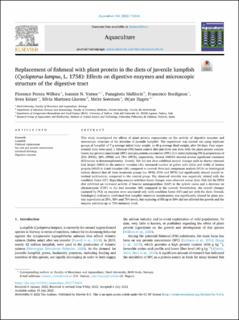Replacement of fishmeal with plant protein in the diets of juvenile lumpfish (Cyclopterus lumpus, L. 1758) : Effects on digestive enzymes and microscopic structure of the digestive tract.
Willora, Florence Perera; Vatsos, Ioannis N.; Mallioris, Panagiotis; Bordignon, Francesco; Keizer, Sven; Martinez-Llorens, Silvia; Sørensen, Mette; Hagen, Ørjan
Peer reviewed, Journal article
Published version
Permanent lenke
https://hdl.handle.net/11250/3009812Utgivelsesdato
2022Metadata
Vis full innførselSamlinger
Originalversjon
Willora, F. P., Vatsos, I. N., Mallioris, P., Bordignon, F., Keizer, S., Martınez-Llorens, S., Sørensen, M. & Hagen, Ø. (2022). Replacement of fishmeal with plant protein in the diets of juvenile lumpfish (Cyclopterus lumpus, L. 1758): Effects on digestive enzymes and microscopic structure of the digestive tract. Aquaculture, 561:738601. doi: https://doi.org/10.1016/j.aquaculture.2022.738601Sammendrag
This study investigated the effects of plant protein concentrates on the activity of digestive enzymes and microscopic structure of the intestine of juvenile lumpfish. The experiment was carried out using triplicate groups of lumpfish of 7 g average initial body weight, to 40 g average final weight, after 54 days. Four experimental diets were used; a fishmeal (FM) based control diet and three test diets with the plant protein concentrates; soy protein concentrate (SPC) and pea protein concentrate (PPC) (1:1 ratio) replacing FM in proportions of 25% (PP25), 50% (PP50) and 75% (PP75), respectively. Nested ANOVA showed several significant treatment differences in histomorphometry. Overall, fish fed test diets exhibited several changes such as shorter mucosal fold height (MFH) in the anterior intestine (AI), increased number of goblet cells (GCs) and width of lamina propria (WLP) in distal intestine (DI), compared to control. Principal component analysis (PCA) on histological indices showed that all three treatment groups (i.e. PP25, PP50 and PP75) had significantly altered overall intestinal architecture, compared to the control group. The observed enteritis was negatively related with the condition factor (CF). Regarding enzyme activities fewer changes were observed across diets. Fish fed the PP50 diet exhibited an increased activity of leucine aminopeptidase (LAP) in the pyloric caeca and a decrease on chymotrypsin (CHY) in the mid intestine (MI) compared to the control. Nevertheless, the overall changes captured by PCA on enzymes were associated only with condition factor (CF) and not with the diets. Overall, histological evaluation confirmed that lumpfish intestinal morphometry was significantly altered by plant protein ingredients at 25%, 50% and 75% levels, but replacing of FM up to 50% did not affected the growth and the enzyme activities up to 75% inclusion level. Replacement of fishmeal with plant protein in the diets of juvenile lumpfish (Cyclopterus lumpus, L. 1758): Effects on digestive enzymes and microscopic structure of the digestive tract.

